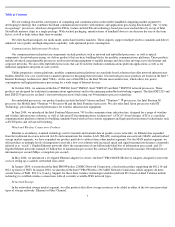Intel 2004 Annual Report Download - page 19
Download and view the complete annual report
Please find page 19 of the 2004 Intel annual report below. You can navigate through the pages in the report by either clicking on the pages listed below, or by using the keyword search tool below to find specific information within the annual report.
Table of Contents
All Intel desktop processors produced in 2004 were capable of taking advantage of the advanced energy-saving features of the Instantly
Available PC platform, which makes it possible to have a high-performance, feature-rich PC that is power efficient when both active and idle,
and remains connected to a network even when powered off. Similarly, the Intel Pentium M processor and Intel Centrino mobile technology
processors were designed specifically for notebook performance and include a variety of energy-saving features such as:
Intel has also moved to improve the energy efficiency of desktop system power supplies by issuing new energy-efficiency targets as part
of our Power Supply Design Guidelines. Power supply efficiencies for desktop computers improved in 2004. We worked with industry peers
and the U.S. Environmental Protection Agency’s Energy Star* program to integrate Intel power supply efficiency requirements into new
Energy Star specifications for desktop computers. Intel also is working with other vendors, industry groups and research institutions to develop
energy-efficient power supplies.
The manufacture, assembly and testing of Intel products require the use of hazardous materials that are subject to a broad array of EHS
laws and regulations. Intel actively reviews what hazardous materials are used in the manufacture, assembly and testing of our products,
particularly materials that end up in the final product. Intel has developed specific restrictions for the use of hazardous materials in our
products, as well as those of our suppliers and outsourced manufacturers and subcontractors. Intel’s proactive efforts to reduce the use of
hazardous substances have positioned us well to meet environmental restrictions on product content throughout the world, such as the
Restriction on Hazardous Substances (RoHS) directive in the European Union. The RoHS directive eliminates most uses of lead, cadmium,
hexavalent-chromium, mercury and certain fire retardants in electronics placed on the market after July 1, 2006. If this directive were in effect
today, it would impact about 85% of Intel products due to the current use of tin-lead solders. Intel published its lead-free product road map in
April 2004, and we already manufacture and ship some products that are RoHS compliant. By the end of 2004, the company shipped several
million RoHS-compliant flash products as well as our first RoHS-compliant CPUs.
As Intel continues to advance process technology, the materials, technologies and products themselves become increasingly complex. Our
evaluations of new materials for use in R&D, manufacturing, and assembly and test take into account EHS considerations and are a component
of Intel’
s design for EHS processes. Many new materials being evaluated for use may be subject to regulation under existing or future laws and
regulations. Failure to comply with any of the applicable laws or regulations could result in fines, suspension of production, alteration of
fabrication and assembly processes, curtailment of operations or sales, and legal liability. Intel’s failure to properly manage the use,
transportation, emission, discharge, storage, recycling or disposal of hazardous materials could subject the company to future liabilities.
Existing or future laws and regulations could require Intel to procure pollution abatement or remediation equipment, modify product designs, or
incur other expenses associated with the laws and regulations. In addition, restrictions on the use of certain materials in our facilities or
products in the future could have a material adverse effect on our operations. Compliance with these complex laws and regulations, as well as
internal voluntary programs, is integrated into our manufacturing and assembly and test processes. To our knowledge, compliance with these
laws and regulations has had no material effect on our operations. We also refer to the information under the heading “Legal Proceedings” in
Part I, Item 3 of this Form 10-K.
16
•
Enhanced Intel SpeedStep technology, which enables the processor to step down to a lower voltage and frequency as the workload
drops, conserving battery power;
•
the ability to turn off parts of the processor’s high-speed memory when not needed, resulting in an overall reduction in platform
power consumption; and
•
lower power consumption in the LCD panel and voltage regulator, which together consume 40% to 50% of platform power.
























